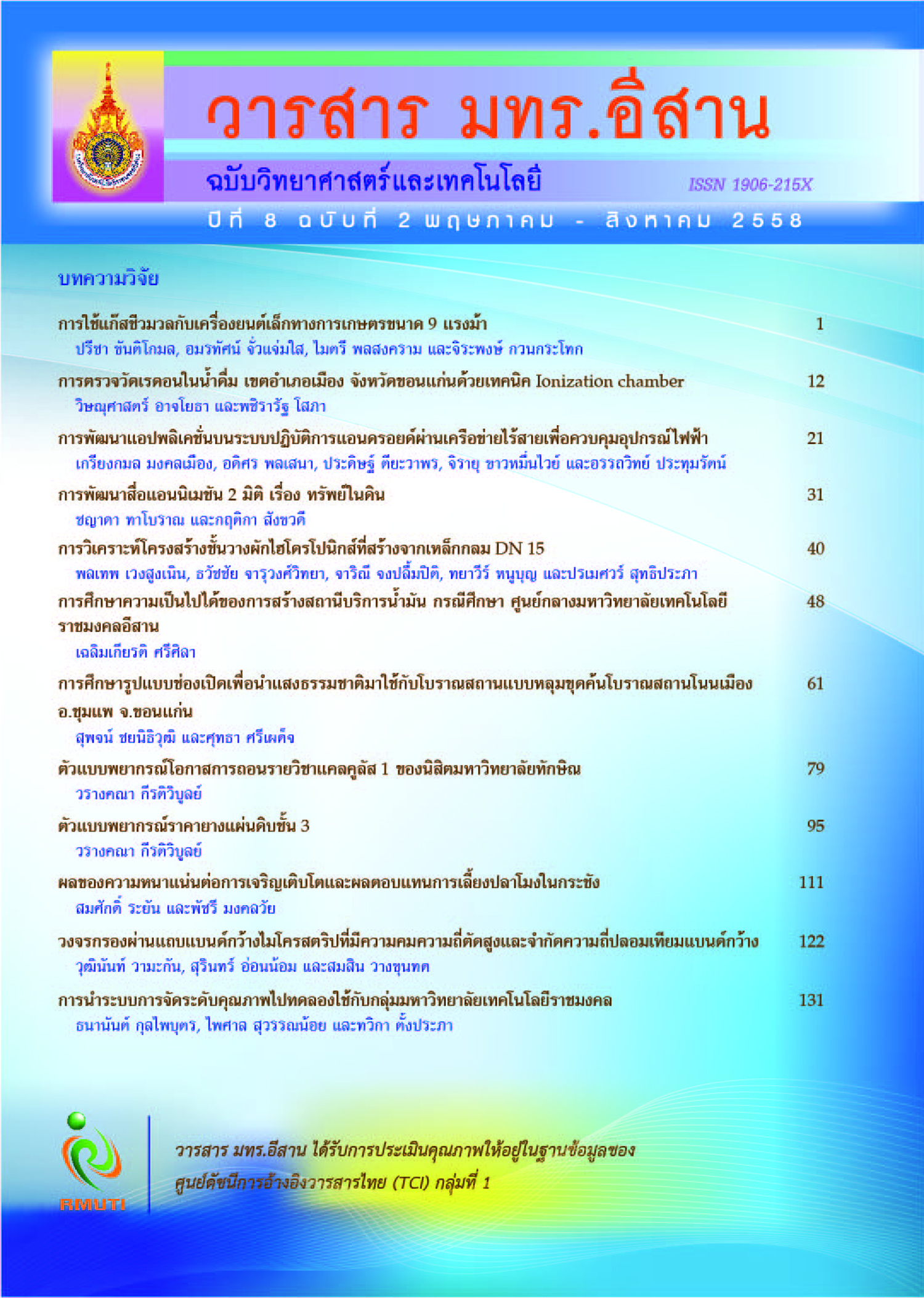การตรวจวัดเรดอนในนํ้าดื่ม เขตอำเภอเมือง จังหวัดขอนแก่น ด้วยเทคนิค Ionization chamber Measurement of Radon in Drinking Water at Amphur Meaung, Khonkhaen Province with Ionization chamber
Main Article Content
บทคัดย่อ
บทคัดย่อ
การตรวจวัดปริมาณความเข้มข้นของเรดอนในตัวอย่างนํ้าบริโภค เขตอำเภอเมือง จังหวัดขอนแก่น จำนวนทั้งหมด 73 ตัวอย่าง โดยใช้เครื่องวัดชนิด Pulse - counting ionization chamber radon gas monitor ATMOS 12 dpx ซึ่งผลการตรวจวัดพบว่าอยู่ในช่วง 0.14 - 0.92 Bq/l และมีค่าเฉลี่ย 0.47 Bq/l เมื่อประเมินค่าความเสี่ยงจากการดูดกลืนรังสีสำหรับผู้ที่บริโภคนํ้าตลอดทั้งปี พบว่าอยู่ในช่วง 0.010 - 0.066 mSv/y และมีค่าเฉลี่ย 0.033 mSv/l ซึ่งงานวิจัยนี้ยังได้เปรียบทียบผลการวิจัยกับค่ามาตรฐานอ้างอิงขององค์การพิทักษ์สิ่งแวดล้อมแห่งประเทศสหรัฐอเมริกา สำหรับเรดอนในนํ้าบริโภค ซึ่งควรมีค่าไม่เกิน 11 Bq/l และค่ารังสีขนาดเสี่ยงของประชาชนที่ใช้นํ้าดื่มตลอดทั้งปี มีค่าไม่เกิน 0.1 mSv/y
Abstract
Determination of Radon concentration in 73 water samples at Amphur Meaung, Khonkhaen Province were determined by measuring activity of Radon using Pulse - counting ionization chamber radon gas monitor ATMOS 12 dpx. The average activity of contaminated of Radon was found to be 0.47 Bq/l, range 0.14 - 0.92 Bq/l. The average risk of absorbed - dose for Drinking Water throughout the year was found to be 0.033 mSv/y, range 0.010 - 0.066 mSv/y. This study also compared the findings with reference to the standard of the United States Environmental Protection Agency for radon in water, which should be no more than 11 Bq/l. The radiation exposure for the public who use this drinking water throughout the year should not exceed 0.1 mSv/y.
Article Details
เอกสารอ้างอิง
ประจาปี พ.ศ. 2010 โรงพยาบาลขอนแก่น. พิมพ์ครั้งที่ 1: ขอนแก่น.
Henrieta Dulaiova and William C. Burnett. (2004). An efficient method for - spectrometric
determination of radium - 226, 228 via maganess fibers. Tallahassee, USA:
Department of Oceanography, Florida State University.
ICRP. (2005b). International Commission on Radiological Protection. Low dose
extrapolation of radiation - related cancer risk. ICRP Publication 99. Ann.
ICRP 35 (4).
M. Forte, R. Rusconi, M.T. Cazzaniga, G. Sgorbati. (2007). The measurement of radioactivity
in Italian drinking waters. Microchemical Journal. Vol. 85. Issue 1. pp. 98-102
M. Tirmarche, J.D. Harrison, D. Laurier, F. Paquet, E. Blanchardon, J.W. Marsh. (2010).
Lung Cancer Risk from Radon and Progeny and Statement on Radon.
ICRP Publication. p. 115
National Research Council: Committee on Risk Assessment of Exposure to Radon in
Drinking Water. (1999). Risk Assessment of Radon in Drinking Water.
Washington, D.C.: National Academy Press.
Richard Cothern and Paul A. Rebers. (1990). Radon. Radium and Uranium in Drinking
Water. Lewis Publishers. pp. 225 - 247.
US EPA (United States Environmental Protection Agency). (1991). National Primary Drinking
Water Regulation Radionuclides (Proposed Rules), Federal Register 56, US EPA
UNSCEAR. (2000). United Nations. Sources and Effects of Lonization Radiation. Volume I:
Sources; Volume II: Effects. United Nations Scientific Committee on the Effects of
Atomic Radiation. Report to the General Assembly with scientific annexes. United
Nations sales publications E.00.IX.3 and E.00.IX.4. United Nations. New York.
WHO (World Health Organization). (2008). Guidelines for Drinking-water Quality,
Third edition incorporating the first and second addenda, WHO, Volume 1, Geneva.


